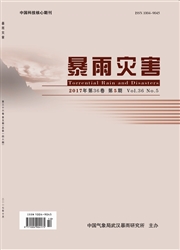

 中文摘要:
中文摘要:
利用ECMWF的逐日再分析资料,通过环流分析和物理量诊断方法,揭示2015年12月9日广东暴雨的产生机理。结果表明:来自东欧高纬度的干冷空气南下对暴雨的发生起了重要作用;干冷空气流经青藏高原时发生绕流,南支气流绕过青藏高原并在孟加拉湾反气旋环流的挟卷作用下经南支槽抵达华南,形成了干冷空气的主要通道。暴雨发生前,暖湿气流主要来自西太平洋,暴雨发生期间,偏东气流转为偏南气流,使南海成为9日暴雨的主要水汽源地。冷暖空气的汇合使暴雨区上空等θse线陡峭,沿等θse面有强烈的上升运动,但上升运动区不存在深厚的位势不稳定。冷空气的南下激发了暴雨区700 h Pa的锋生,其中水平变形项和水平辐合项对锋生有正贡献。锋生激发了正的次级环流,环流中心也位于700 h Pa,这有利于气流的抬升,故锋生及次级环流是暴雨区上升运动发展的重要机制。
 英文摘要:
英文摘要:
Based on ECMWF daily reanalysis data, the mechanism of the heavy rain event occurred in Guangdong Province on 9 December2015 was revealed by conducting circulation and diagnostic analysis. The results show that the southward moving dry cold air from eastern Europe has played an important role in exciting the heavy rain; the dry cold air flows around the Tibetan Plateau when flowing through; southern branch of the airflow around the Tibetan Plateau is entrained under the action of the anticyclonic circulation in the Bay of Bengal and the cold air reaches southern China via the Southern branch trough, which forms the main channel of dry cold air. Moist warm air comes from the Western Pacific before the heavy rain, and the easterly flow turns into southerly flow on Dec.9 2015, thus South China Sea becomes the main source of water vapor of the heavy rainfall. The convergence of cold and warm air masses contributes to the steep slope of potential pseudo-equivalent temperature. There is strong upward movement along the slope. But there is no deep potential instability in the ascending motion area. The southward motion of the cold air triggers the frontogenesis which centers in 700 h Pa. The terms of horizontal deformation and horizontal convergence have positive contributions to the frontogenesis. Frontogenesis stimulates positive secondary circulation centering at700 h Pa, which contributes to the uplifting of the airflow, so the frontogenesis with the secondary circulation is the important mechanism of the upward movement in this heavy rainstorm region.
 同期刊论文项目
同期刊论文项目
 同项目期刊论文
同项目期刊论文
 Mesoscale Energy Spectra of the Mei-Yu Front System. Part II: Moist Available Potential Energy Spect
Mesoscale Energy Spectra of the Mei-Yu Front System. Part II: Moist Available Potential Energy Spect Analysis and numerical study of a hybrid BGM-3DVAR data assimilation scheme using satellite radiance
Analysis and numerical study of a hybrid BGM-3DVAR data assimilation scheme using satellite radiance Applications of a Moist Nonhydrostatic Formulation of the Spectral Energy Budget Part I: The Lower-S
Applications of a Moist Nonhydrostatic Formulation of the Spectral Energy Budget Part I: The Lower-S 期刊信息
期刊信息
